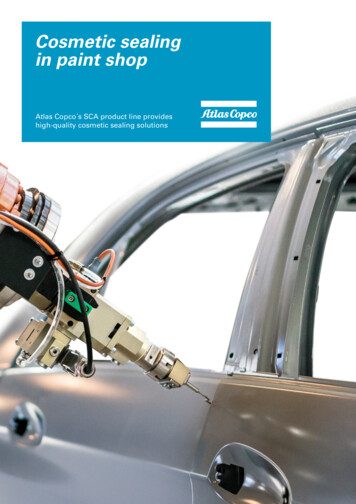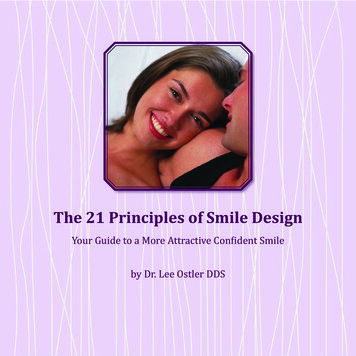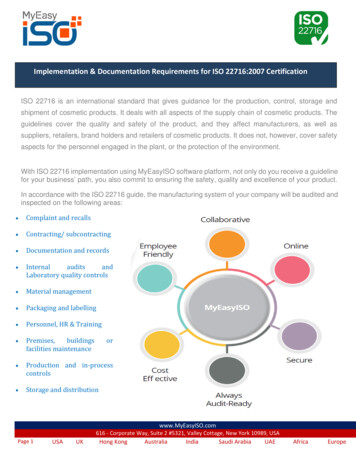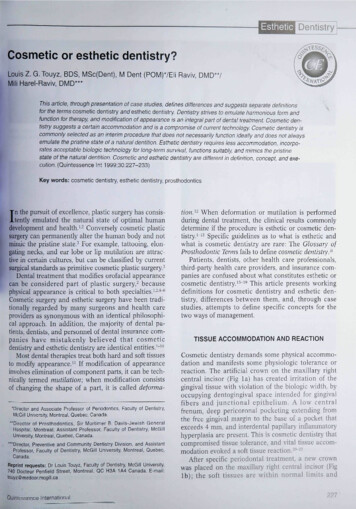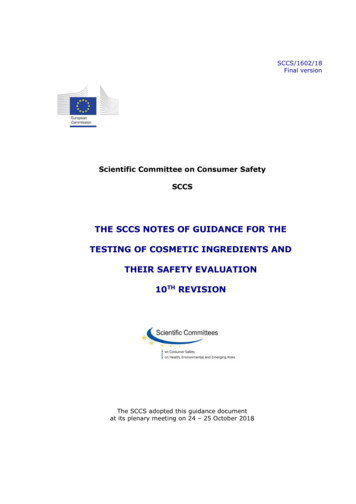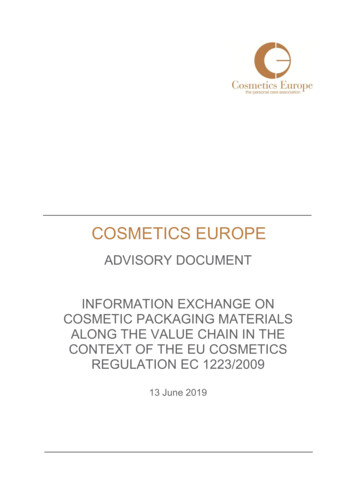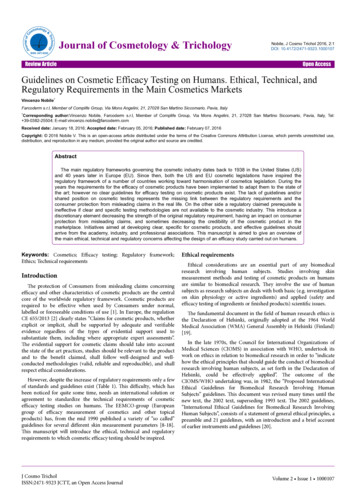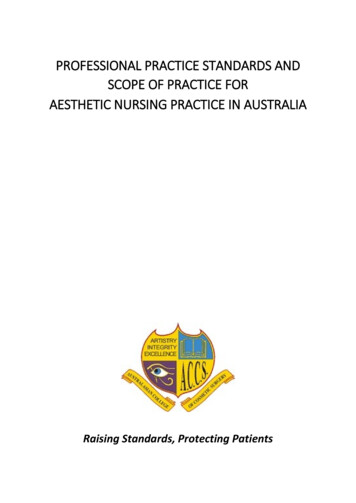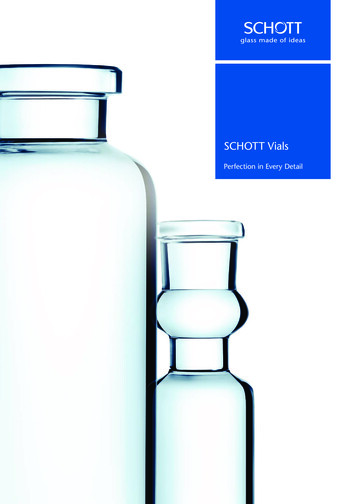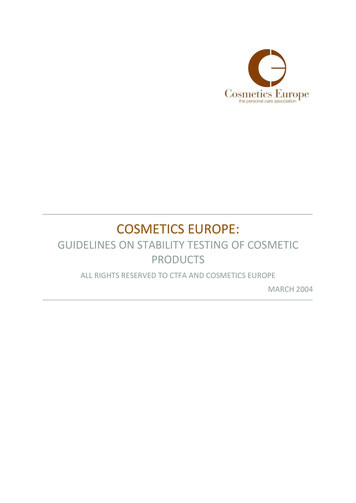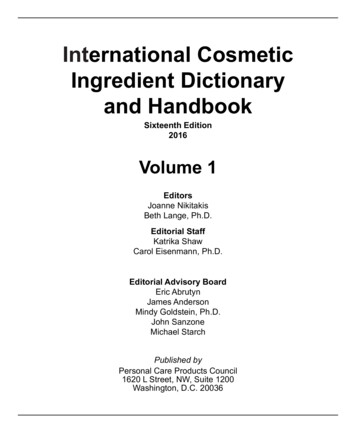
Transcription
COSMETIC MEDICAL AND SURGICAL PROCEDURESA NATIONAL FRAMEWORKFINAL REPORTINTER-JURISDICTIONAL COSMETIC SURGERY WORKING GROUPCLINICAL, TECHNICAL AND ETHICAL PRINCIPAL COMMITTEEAUSTRALIAN HEALTH MINISTERS’ ADVISORY COUNCIL
Australian Health Ministers’ Conference 2011This (report) was prepared under the auspices of the Australian Health Ministers’ Conference.Copies can be obtained from http://www.health.nsw.gov.au/pubs/2012/cosmetic surgery.htmlEnquiries about the content of the report should be directed to cpuocho@doh.health.nsw.gov.au
CONTENTSExecutive Summary3Summary of National Framework Featuresand Recommended Actions7Background to the Project15Establishment and Terms of Reference15Scope16Methodology17Cosmetic Surgical and Medical Practice19What is it?19Who does it?19Where is it done and how much is done?22How is it Regulated?25Professional registration26Private health facilities licensing29Medicare, accreditation, professional29indemnity insuranceCommon Law obligations31Drugs and Injectables31Lasers and Intense Pulsed Light Sources32Fair Trading33Advertising, marketing and promotion341
A National Framework37Why is a national framework needed?37What should a national framework capture?40The Procedures41The Promotion of the procedures42The Practitioner45- Registered Practitioners46- Unregistered Practitioners53The Patient57The Place6466General IssuesReferences67AttachmentsAttachment 1 – Developments since NSWCosmetic Surgery Report –Summary69Attachment 2 - Good Medical Practice – Code ofConduct for Doctors in Australia –Supplementary Guidelines forCosmetic Medical and SurgicalProcedures73Attachment 3 - ISAPS/ASAPS Guidelines on SurgicalTourism78Attachment 4 - The Australasian Society of AestheticPlastic Surgery – Position Statementon Cosmetic Tourism812
EXECUTIVE SUMMARYThe Australian Health Ministers' Conference requested an examination of theadequacy of consumer safeguards in relation to cosmetic medical and surgicalprocedures.The Australian Health Ministers' Advisory Council referred the matter to its Clinical,Technical and Ethical Principal Committee, which established the Inter-jurisdictionalCosmetic Surgery Working Group to undertake the review.The Working Group was tasked with identifying, and reviewing the adequacy of,consumer safeguards in relation to cosmetic medical and surgical procedures and inparticular, safeguards relating to advertising, marketing and recruitment; informationavailable to consumers and informed consent (including any specific issues forpersons under 18 years of age); regulatory coverage; and professional/clinicalstandards of practice.The Working Group was requested to make recommendations to the AustralianHealth Ministers’ Conference on the need for and nature of additional safeguards forconsumers and to identify options for progressing such safeguards through anational framework or baseline of requirements.For the purpose of scoping its task, the Working Group defined cosmetic surgery asa procedure performed to reshape normal structures of the body or to adorn parts ofthe body, with the aim of improving the consumer’s appearance and self-esteem.Reconstructive surgery, being surgery which is performed on abnormal structures ofthe body caused by congenital defects, developmental abnormalities, trauma,infection, tumours or disease, was excluded. This is usually done to improvefunctions, but may also be done to approximate a normal appearance.The project excluded gender reassignment surgery; tattooing; body piercing andcosmetic dentistry.The overall pictureCosmetic medical and surgical procedures, depending on the nature of theprocedure, are mostly performed by medical practitioners, with nurses and beautytherapists also playing a role.Procedures are performed in a variety of settings, including hospitals, day procedurecentres and medical practitioners’ rooms. Cosmetic surgical procedures areincreasingly being performed in day procedure centres, and with rapidly changingtechnology providing alternatives to traditional surgical procedures, many procedures(such as liposuction, laser skin treatments and sclerotherapy [injection of a solution3
into unwanted varicose and spider veins]) are now being done in medicalpractitioners’ rooms.Non-surgical procedures are a burgeoning area of activity – laser hair removal,injections, microdermabrasion and light and medium skin peels are being performedin medical practitioners’ rooms and in beauty salons.It is a rapidly growing and changing industry which is difficult to quantify. Industryestimates suggest that cosmetic surgery is now a billion-dollar industry and nonsurgical procedures have seen about a 40-50% increase over the last five years.“Cosmetic tourism” is another growing area – increasingly, individuals are travellingto other countries, such as in south-east Asia, in search of low cost treatment, oftenas part of “package tour” deals where the cosmetic procedure forms an incidentalpart of the trip.It is not possible to estimate how many Australians travel overseas for cosmeticmedical and surgical procedures. Overseas reports indicate that the market inmedical tourism is currently estimated to be between 20 and 40 billion US dollarsannually, predicted to reach 100 billion within two years.The current regulatory framework within which cosmetic medical and surgicalprocedures are practised around Australia consists of a combination of – professional (practitioner) registration; private health facilities licensing; public health measures (eg infection control); regulation of some of the devices and substances used in performing theprocedures; independent health complaints mechanisms; and more general consumer legislation, including in some jurisdictions, specificprotection in relation to children.Not all jurisdictions have all of the above measures in place and where they do havethem in place, they are not necessarily consistent.Consumer safeguards and their adequacyCosmetic medical and surgical procedures are lifestyle choices, undertaken toenhance appearance to achieve what patients perceive to be more desirable and toboost self-esteem and confidence – they are not driven by medical need.4
The cosmetic medical and surgical industry has become a multi-million dollarentrepreneurial industry. Rapid and ad hoc growth has opened the way forunregulated practices and some questionable methods of promotion, posing ethicaldilemmas for some members of the medical profession, consumers and legislators.Advertising and promotion of cosmetic medical and surgical procedures focus on thebenefits for the consumer, downplaying or not always mentioning the risks. Different“boundaries” are tolerated for promotion of these procedures (which are not drivenby medical need and where there is significant opportunity for financial gain by thosepromoting them) than is the case for “mainstream” medical procedures.Factual, easily understood information for consumers contemplating cosmeticmedical or surgical procedures from a source that is independent of practitioners andpromoters is not always readily available.While cosmetic medical and surgical procedures are undertaken by some medicalpractitioners who have completed advanced specialist surgical or medical training,current regulatory provisions allow any registered medical practitioner to set up inpractice and call themselves a cosmetic surgeon or physician, conveying theimpression that they are specifically qualified or specialise in the area.In other areas of medicine, the general practitioner (GP) is the ‘gatekeeper’ forreferral to surgeons. Where the cosmetic surgery industry sells procedures directlyto the public, a GP referral is not required. This means the GP is not able to offer anindependent view on the procedure unless specifically sought by the patient. TheGP is also potentially uninvolved in post-procedural care.Unregistered practitioners in the industry are largely able to operate independently,without a common code of conduct or a common set of core practice standards. Useof Schedule 4 substances (eg Botox) in their work raises issues related to access towhat are prescription-only substances and the qualifications training and oversight ofthose who administer them. Use of devices such as lasers and intense pulsed lightsources in their work is not regulated in all jurisdictions and training is variable.It is difficult to assess the extent to which the current regulatory framework providesor maintains consumer safeguards because there are few sources of information.Medical insurance claims data suggests that medical practitioners working in thearea of cosmetic practice have a higher claims frequency, which has increased at amuch higher rate over the last ten years, than the average for all insured doctors.The most common reason for claims was dissatisfaction with the results.5
A National FrameworkWhere jurisdictions have moved to implement specific measures in relation to thecosmetic medical and surgical industry, it has usually been in response to localconcerns about safety and quality of procedures and promotional methods. As theindustry continues to expand rapidly across jurisdictions in an ad hoc way andconsumer demand continues its dramatic increase, those concerns have becomemore widespread.Australia implemented a national scheme of registration and accreditation for healthprofessionals from 1 July 2010. It is also moving towards a national model of safetyand quality accreditation for health care organisations, including a set of nationalsafety and quality health service standards. It is producing recommendations fornationally uniform regulation of lasers and intense pulsed light sources. It isundertaking a national examination and consultation on options for regulation ofunregistered practitioners.To that extent, the die is already cast for a national approach or framework coveringmany aspects of the cosmetic medical and surgical industry.The Working Group considered that a baseline of requirements within a nationalframework would provide consumers with some assurance of consistency instandards of conduct in the cosmetic medical and surgical industry across thecountry.It considered that there were five interdependent elements that formed the linchpinsfor the national framework – the procedures, the promotion of the procedures, thepractitioner, the patient and the place. Enhancement of consumer safeguardsrequires all five to work together. Recommendations are made in relation to each ofthe five elements.Since the Working Group commenced the project, significant progress has beenmade in advancing the national initiatives. That has clarified the national contextwithin which the project has been undertaken and has defined the mechanismsthrough which many of the recommendations can be progressed.The national registration boards under the national registration and accreditationscheme for health professionals have been established. Two of the boards – theMedical Board of Australia and the Nursing and Midwifery Board of Australia – havejurisdiction over the two main groups of registered practitioners involved in cosmeticmedical and surgical procedures – medical practitioners and nurses. Many of therecommendations are directed for the boards’ attention.The cosmetic medical and surgical industry is a rapidly growing and changingindustry. In that sense, the Working Group’s recommendations are a “work-inprogress”. It recommends that the national boards keep the situation under review.6
SUMMARY OF NATIONAL FRAMEWORK FEATURES ANDRECOMMENDED ACTIONSNational Framework There should be a national framework covering cosmetic medical and surgicalprocedures, which includes a baseline of requirements. The national framework should be based on five interdependent elements – theprocedures, the promotion of the procedures, the practitioner, the patient and theplace.The Procedures - definitionFramework Feature:There should be consistency in the definition of cosmetic medical and surgicalproceduresRECOMMENDED ACTION The term "cosmetic medical and surgical procedures" be the terminology used tocapture cosmetic procedures within the national framework. That term is furtherdefined as"operations and other procedures that revise or change the appearance, colour,texture, structure or position of normal bodily features with the sole intention ofachieving what the patient perceives to be a more desirable appearance orboosting the patient’s self-esteem"7
The Promotion of the ProceduresFramework Feature:There should be restrictions on advertising specific to cosmetic medical and surgicalprocedures by both registered professions and unregistered practitionersOffering of cosmetic medical and surgical procedures as a prize should be prohibitedRECOMMENDED ACTION: The Medical Board of Australia monitor compliance with its recent AdvertisingGuidelines, particularly in relation to cosmetic medical and surgical practice. The Nursing and Midwifery Board of Australia monitor compliance with its recentAdvertising Guidelines, particularly in relation to nurses practising independentlyand offering cosmetic medical and surgical procedures. When the National Law is next subject to substantive amendment, considerationbe given to the need to further strengthen its provisions to prohibit the offering ofgifts and inducements to attract people to undergo cosmetic medical and surgicalprocedures, and particularly to prohibit time-limited discounts. The offering of cosmetic medical and surgical procedures as a prize be prohibited(noting that this had been achieved under Lotteries legislation in threejurisdictions).Note – in relation to unregistered practitioners, recommendations for further work aregrouped at the end of the Recommendations section.The PractitionerFramework Feature:Treatment should only be provided if the practitioner has appropriate training,expertise and experience in the procedure;In relation to follow-up care, the medical practitioner should be available personallyor have a formal arrangement with another suitably qualified practitioner who has fullaccess to the patient's history and these arrangements should be made known to thepatient;8
In relation to medical practitioners, the use of the title "specialist" should be restrictedto those having specialist recognition;Medical practitioners should be prevented from entering into financial incentivearrangements with agents who refer patients;In relation to nurses, treatment should only be provided if the nurse has appropriatetraining, expertise and experience in the procedure;Where nurses are administering scheduled drugs or undertaking other high riskprocedures in relation to cosmetic medical and surgical procedures, some asindependent practitioners, this should be done in accordance with applicable laws,protocols and best practice standards;Where unregistered practitioners are involved in providing cosmetic medical andsurgical procedures, they should be provided in a safe and ethical manner.RECOMMENDED ACTION Medical Practitioners The Medical Board of Australia consider supplementing the Code “GoodMedical Practice: A Code of Conduct for Doctors in Australia” withSupplementary Guidelines specifically covering cosmetic medical and surgicalpractice. (Attachment 2 provides a full draft of possible content of theproposed Supplementary Guidelines.) In particular, the proposedSupplementary Guidelines should emphasise that o Treatment should only be provided if the medical practitioner has theappropriate training, expertise and experience in the particularcosmetic procedure being performed to deal with all routine aspects ofcare and any likely complications;o The medical practitioner is responsible for ensuring he or she has thenecessary training, expertise and experience to perform a particularcosmetic procedure with reasonable care and skill. The Medical Board of Australia, in collaboration with medical colleges andprofessional associations, undertake a review of the minimum training andaccreditation standards for medical practitioners performing cosmetic medicaland surgical procedures o The review process could be informed by the Australian MedicalCouncil processes;9
o The review should encompass the need for processes to be in place toensure that medical practitioners undertaking cosmetic medical andsurgical procedures are part of a program of peer review and ongoingaudit. In association with the review of training and accreditation standards, theMedical Board of Australia give further consideration to the use of titles, listsof qualifications and memberships so that the public is not misled intobelieving that someone who specialises in a particular form of treatment is infact a "specialist" if not so recognised through established processes. Use oftitles, qualifications and memberships should not imply that the practitioner ismore skilled or has greater experience than is the case. The Medical Board of Australia consider including in the SupplementaryGuidelines to the Code “Good Medical Practice: A Code of Conduct forDoctors in Australia” provisions in relation to after-care. The provisionsshould make explicit the responsibility of the medical practitioner carrying outthe cosmetic procedure to ensure there are protocols in place to cover allaspects of post-operative (post-procedural) care, including the full range ofcomplications. The patient should be provided with specific writteninformation on post-operative (post-procedural) instructions and after-carearrangements. The Medical Board of Australia consider including in the SupplementaryGuidelines to the Code “Good Medical Practice: A Code of Conduct forDoctors in Australia” more explicit provisions to achieve the following:o Medical practitioners be prevented from entering into financial incentivearrangements with agents who recruit patients for procedures (egpayment of a commission for patients recruited).o Medical practitioners be prevented from offering financing schemes topatients (other than credit card facilities), either directly or through athird party, such as loans, as part of their cosmetic medical or surgicalservices.Nurses The Nursing and Midwifery Board of Australia consider the need for thedevelopment of supplementary guidelines to its code of professional conduct,specifically dealing with cosmetic medical and surgical procedures (including,for example, guidelines or a protocol for cosmetic Schedule 4 injections).10
Unregistered practitioners Nationally uniform regulation of lasers and intense pulsed light sources (IPLs)should capture unregistered practitioners. The work of the ARPANSAworking group tasked with producing such recommendations should beconcluded as soon as possible.The PatientFramework Feature:There should be restrictions relating to the performance of cosmetic medical andsurgical procedures on children;There should be specific requirements relating to obtaining consent for theperformance of cosmetic medical and surgical procedures on adults;There should be reliable, accessible information available to consumers to assistthem in making an informed choice about whether or not to undergo a cosmeticmedical or surgical procedure;The patient should recognise their responsibility to truthfully disclose their medicalhistory, to enable the practitioner to accurately assess each patient's risk;There should be accessible avenues for complaint, irrespective of whether thepractitioner is a registered health professional or an unregistered practitioner.RECOMMENDED ACTION – The Medical Board of Australia consider including in the SupplementaryGuidelines to the Code “Good Medical Practice: A Code of Conduct for Doctors inAustralia” specific provisions relating to the undertaking of cosmetic medical andsurgical procedures to achieve the following In relation to adults: the first consultation should be with the operating medical practitioner, not with anagent/patient adviser there must be an assessment of the person's motivation for seeking treatment there is a need to ensure the person has realistic expectations11
there should be an opportunity for a person to be referred for psychologicalevaluation informed written consent should be obtained at a pre-procedure consultation within areasonable time period before the day of the procedure and re-confirmed on the dayof the procedure a cooling-off period between the initial consultation and performance of theprocedure should be encouraged (but not mandated)In relation to persons under 18 years of age, the above provisions should besupplemented or replaced (where the intent is inconsistent) by the following: if the requested surgery/procedure has no medical justification there must be a'cooling off' period of 3 months, followed by a further consultation during which therequest is further explored. The requested surgery/procedure should not bescheduled at the initial consultation. the person should be encouraged to discuss their desire for the surgery/procedureand any concerns with their general practitioner during the cooling off period. in addition, there should be a requirement for the person to be assessed by anappropriately qualified health professional (eg psychiatrist, psychologist or specialistcounsellor) The above provisions also be referred for the attention of the Nursing andMidwifery Board of Australia, for potential inclusion (as appropriate) insupplementary guidelines to its code of conduct, specifically dealing withcosmetic medical and surgical procedures, to cover those situations wherenurses are practising independently. There should be broader availability of factual, easily understood information forconsumers contemplating cosmetic medical or surgical procedures from a sourcethat is independent of practitioners and promoters. The consumer informationresource being produced in Victoria be reviewed when available and consideredfor adoption nationally. The patient's responsibility to truthfully disclose their medical history, to enablethe medical practitioner to accurately assess each patient's risk, be clearly statedin consumer information packages. “Medical history” includes allergies, currentmedications (including complementary and alternative therapies), social habitsand previous operations. The consumer information resource include specific information relevant tocosmetic ‘tourism’ along the lines of the ISAPS/ASAPS guidelines or TheAustralasian Society of Aesthetic Plastic Surgery’s Position Statement onCosmetic Tourism included as Attachments 3 and 4.12
Arrangements for handling complaints against registered practitioners under thenew national registration scheme be monitored as the scheme is consolidated.THE PLACEFramework Feature:No matter where a medical practitioner undertakes cosmetic medical and surgicalprocedures, infection control and other standards should applySimilar standards should apply in relation to higher risk procedures undertaken byunregistered practitionersRECOMMENDED ACTION Jurisdictions use their best endeavours to ensure their legislation will enable theimplementation of the proposed new national model of safety and qualityaccreditation being developed by the Australian Commission on Safety andQuality in Health Care, so that cosmetic medical and surgical procedures,wherever they occur in Australia, must be in accordance with key national safetyand quality health service standards (eg infection control).GENERAL The Medical and Nursing and Midwifery Boards of Australia maintain a ‘watchingbrief’ on developments in the cosmetic medical and surgical industry as theyrelate to registered practitioners under their jurisdiction.13
RECOMMENDATIONS FOR FURTHER WORKUNREGISTERED PRACTITIONERSThere is to be a national project and consultation process on the regulation ofunregistered health practitioners. The scope of the project as it proceeds toconsultation is understood to be broad. The Working Group has made a number ofobservations where it believes that, in the interests of consumer protection, thereshould be consistency in the requirements on unregistered practitioners undertakinghigher risk cosmetic medical and surgical procedures, such as beauty therapists,with those recommended for registered practitioners. It is therefore recommended that this report be made available to the projectgroup undertaking the national project. In particular, the following points are recommended for consideration – services should be provided in a safe and ethical manner; advertising constraints consistent with those outlined in relation tothe registered professions (medical practitioners and nurses) shouldalso apply to unregistered practitioners where they are offeringcosmetic medical and surgical procedures; the requirements outlined in relation to the registered professionsfor assessment, ensuring realistic expectations, cooling-off periods,informed consent and consumer information should be taken intoconsideration in relation to those cosmetic medical and surgicalservices of beauty therapists which are higher risk and can causephysical responses potentially requiring medical intervention; appropriate standards should apply to premises where cosmeticmedical and surgical procedures are carried out; robust and accessible complaints mechanisms should be availablein relation to unregistered practitioners where they are offeringcosmetic medical and surgical procedures.14
BACKGROUND TO THE PROJECTEstablishment and Terms of Reference The South Australian Minister for Health submitted an agenda paper to the July 2008Australian Health Ministers’ Conference (AHMC) seeking support for investigation bythe Australian Health Ministers’ Advisory Council (AHMAC) of measures that couldbe taken to regulate the cosmetic surgery industry to provide greater consumerprotection.The agenda paper was prompted by concerns about the growth in advertising andmarketing of cosmetic surgical and medical procedures and its potential to createconfusion in the community about titles, memberships and qualifications. There wasalso concern about the potential for public demand for such procedures to driveinappropriate business activities to meet the demand, and for the increasedpossibility of unrealistic and unmet expectations of the public.Of further concern, two States in recent years had recorded the deaths of youngadults following a cosmetic procedure (liposuction in both cases), both of which weresubject to Coronial investigation.AHMC agreed to an investigation, with the matter being referred to the Clinical,Technical and Ethical Principal Committee (CTEPC) of AHMAC to progress. SouthAustralia was requested to take the project lead and to establish an Interjurisdictional Working Group. The Working Group consisted of members from HealthDepartments and the Australian Commission on Safety and Quality in Health Carewith backgrounds in clinical care, medical administration, clinical and health policy,safety and quality, workforce and legislation.The Terms of Reference of the Working Group were:1. To identify, and review the adequacy of, consumer safeguards in relation to cosmeticmedical and surgical procedures and in particular, in relation to –ooooAdvertising, marketing and recruitmentInformation available to consumers and informed consent (including anyspecific issues for persons under 18 years of age)Regulatory coverageProfessional/clinical standards of practice2. To make recommendations to the Australian Health Ministers’ Conference (AHMC),through the Clinical, Technical and Ethical Principal Committee (CTEPC) of theAustralian Health Ministers’ Advisory Council (AHMAC), on the need for and natureof additional safeguards for consumers15
3. To identify in the report to AHMC options for progressing such safeguards through anational framework or baseline of requirementsScopeThe Working Group was aware of The Cosmetic Surgery Report - Report to theNSW Minister for Health - October 19991. Taking into account the relative recencyof the report, its Australian context and its comprehensive nature - arguably the mostcomprehensive review on the topic undertaken in Australia to date - the WorkingGroup used that report as a reference point. For the purposes of scoping theproject, the Working Group used the following definition of cosmetic surgery (notingthat the Cosmetic Surgery Report had used a similar definition):“a procedure performed to reshape normal structures of the body or to adorn parts ofthe body, with the aim of improving the consumer’s appearance and self-esteem”noting that oooThe notion of ‘improvement of appearance’ is a subjective one, defined by theconsumer;Cosmetic surgical and medical procedures are initiated by the consumer, not bymedical need;Cosmetic surgical and medical procedures include any cosmetic treatment,including invasive cosmetic surgery, cosmetic injections (pharmaceuticals), andother cosmetic procedures (ie lasers)“Cosmetic surgery” excludes reconstructive surgery, being surgery which isperformed on abnormal structures of the body caused by congenital defects,developmental abnormalities, trauma, infection, tumours or disease. This is usuallydone to improve functions, but may also be done to approximate a normalappearance.The project excluded gender reassignment surgery; tattooing; body piercing andcosmetic dentistry. Gender reassignment surgery was excluded because of thecomplex clinical issues involved. It was also noted that gender reassignment in somejurisdictions is covered by specific law, which sets parameters around the conduct ofsuch procedures and/or enables a person to be legally identified as the opposite sexto that identified by a birth certificate. Tattooing, body piercing and associated bodymodification activities were excluded taking into account that they are generallycovered by public health legislation dealing with skin penetration procedures, whichmay require businesse
medical and surgical procedures - medical practitioners and nurses. Many of the recommendations are directed for the boards' attention. The cosmetic medical and surgical industry is a rapidly growing and changing industry. In that sense, the Working Group's recommendations are a "work-in- progress".
